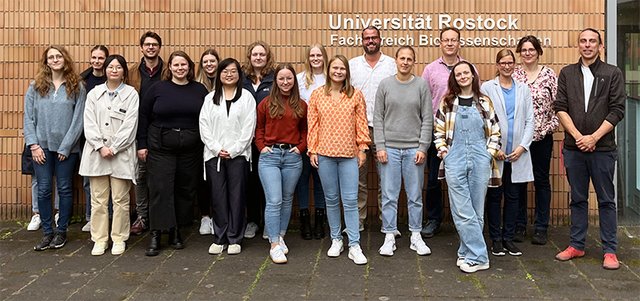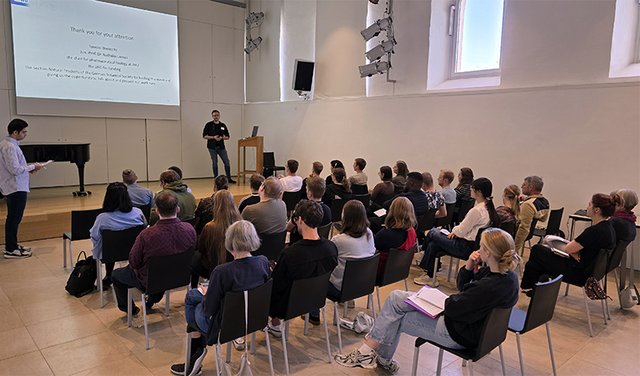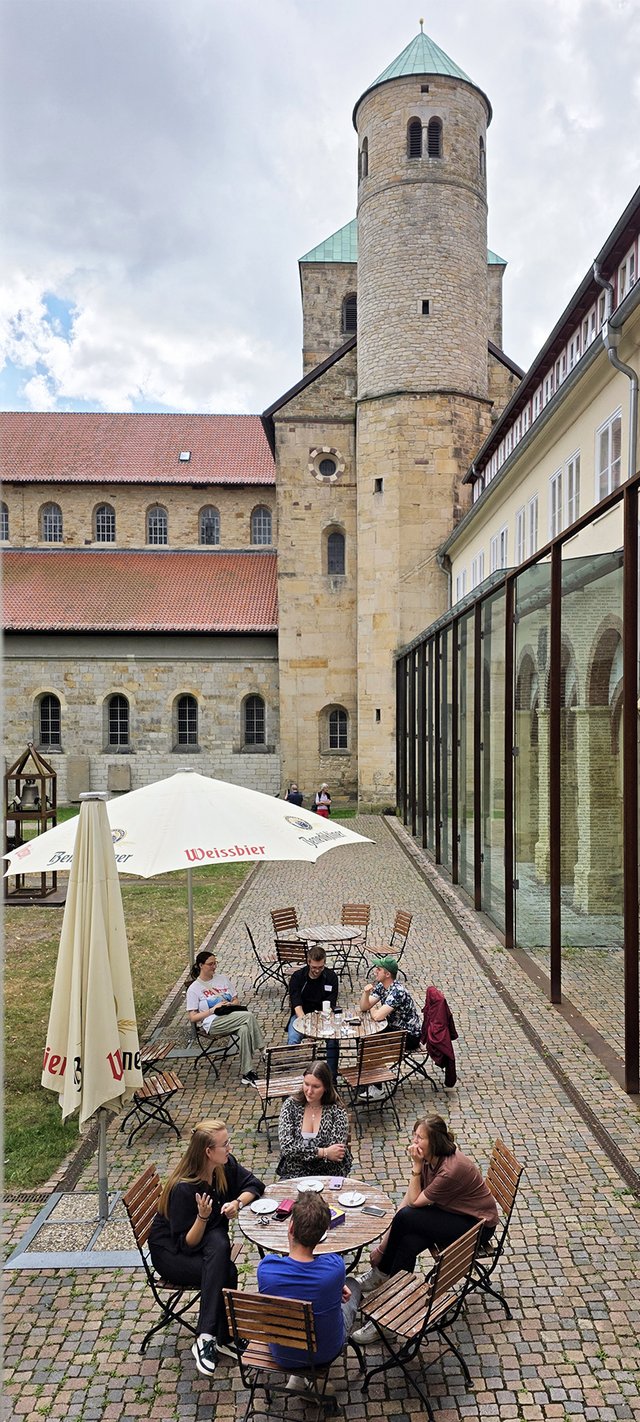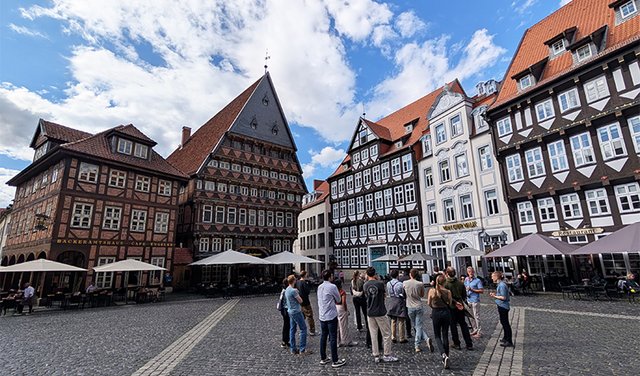Eröffnung und Einstieg ins wissenschaftliche Programm
Die Tagung wurde mit einer Begrüßung durch Dr. Maike Lorenz und Prof. Dr. Claudia Büchel, Sprecherin unserer Sektion, eröffnet. Dr. Lorenz verwies auf die lange Tradition der Universität Göttingen in der Algenforschung und stimmte alle anwesenden Algenforscher*innen auf ein spannendes wissenschaftliches Programm ein.
Gleich darauf folgte die erste Session mit Vorträgen zur Algen-Genetik. Hier wurden genetische Manipulationen bei Algen behandelt, einschließlich der Bearbeitung des Nukleargenoms in Chlamydomonas reinhardtii zur Verbesserung der Lichttoleranz sowie der Nutzung von cis-regulatorischen Elementen zur Untersuchung der Genfunktion. Weitere Vorträge befassten sich mit photoprotektiven Mechanismen in Kieselalgen und der Identifikation genetischer Grundlagen für die drei Geschlechtsphänotypen in der Grünalge Pleodorina starrii.
Den Vorträgen folgte die erste Poster-Session. Wie auch bei den Vorträgen erhielten hier vor allem Nachwuchswissenschaftler*innen – Doktorand*innen und PostDocs – die Möglichkeit, ihre Ergebnisse mit den Teilnehmenden zu diskutieren.
Schüler*innenpreis zum dritten Mal verliehen
Die Sektion Phykologie sieht sich der Nachwuchsförderung verpflichtet und vergibt im Rahmen der Tagung alle zwei Jahre ihren „Schüler*innen-Preis“, um junge Talente frühzeitig für die Algenforschung zu begeistern. In diesem Jahr gewannen Maddox Srey-Ouch und Witalij Plett vom Immanuel-Kant-Gymnasium und Schülerforschungszentrum in Tuttlingen (Baden-Württemberg) mit ihrem Biotechnologie-Projekt „Photopower – Energie aus Algen“. Sie untersuchten die Produktion von Energieträgern mit Hilfe der Grünalge Chlamydomonas. In einem 20-minutigen Vortrag präsentierte Maddox neben den Projektergebnissen souverän die Versuchsplanung, vielseitige Methodenanwendung und den kreativen Umgang mit experimentellen Herausforderungen.
Keynote-Vortrag von Dr. Susana M. Coelho über Fortpflanzungsbiologie
Der erste Tag der Tagung wurde mit einem Highlight beschlossen, dem Keynote-Vortrag von Dr. Susana Coelho (Direktorin am MPI Biologie, Tübingen) zum Thema "The curious world of brown algal mating rituals". Sie stellte ihre Forschung zu Fortpflanzungsmechanismen von Braunalgen und deren evolutionäre Bedeutung vor. Im Vortrag wurde auch auf spannende Weise darauf eingegangen, wie ausgehend von den ersten morphologischen Beschreibungen der Fortpflanzung der Braunalgen und Genomsequenzierungen von Modellalgen wie Ectocarpus es möglich war, tiefe Einblick in Regulationsmechanismen ihrer sexuellen Lebenszyklen zu erlangen.
Tag 2: Vielfältige wissenschaftliche Themen
Der zweite Tag bot ein hochwertiges Programm mit drei Vortrags-Blöcken und der zweiten Poster-Session. Aufgelockert wurde der Tag durch Stadtführungen. Abends fand die Mitgliederversammlung der Sektion Phykologie und die traditionsreiche Auktion phykologischer Schätze statt; sen. Prof. Christian Wilhelm, unterstützt durch Dr. Vivien Hotter, leitete die Auktion mit viel Humor, was die eifrigen Biet-Wettkämpfe noch weiter antrieb. Der Erlös der Auktion wird von der Sektion Phykologie für die Nachwuchsförderungen verwendet.
Session 2: Stressreaktionen und Anpassungen bei Algen
Die Vorträge der zweiten Session untersuchten, wie sich die photosynthetische Effizienz von Braunalgen-Populationen unter Erwärmung verändert, welche Schutzmechanismen Kieselalgen unter Stress einsetzen und welche Rolle phenolische Verbindungen in der Stressresistenz der Zygnematophyceae spielen. Weitere Vorträge befassten sich mit den Schutzmechanismen konjugierender Grünalgen gegenüber Starklicht und der Aktivität benthischer Kieselalgen im Dunkeln.
Session 3: Algen in extremen Umgebungen und Anwendungen
Begonnen wurde die dritte Session mit einem Vortrag über die mögliche Nutzung von Algenanschwemmungen als Nährstoffquelle für Küstenpflanzen. Auch die Anpassungen von Gletschereisalgen an extreme Lichtverhältnisse und metabolische Veränderungen in Dunkelheit wurden vorgestellt, sowie Untersuchungen zum Einfluss der Nährstoffaufnahme auf die Pigmentierung von Algen. Angewandte Themen umfassten den Einsatz nativer Algenproteine als Ersatz für Serum in der Zellkultur sowie die cyanobakterien-getriebene Biokatalyse als nachhaltige Methode zur Produktion chemischer Vorstufen in der synthetischen Biologie.
Session 4: Algen in der Biotechnologie und Umweltmanagement
Die Vorträge der vierten Session umfassten einen Überblick über die industrielle Mikroalgen-Biotechnologie in Deutschland, das Potenzial von Rotalgen als Kohlenstoffspeicher und die Rolle von Algen-Bakterien-Zusammenschlüssen in der Bioremediation und Abwasserreinigung. Ein Vortrag zur Grünalge Botryococcus braunii demonstrierte ein skalierbares Verfahren zur Gewinnung extrazellulärer Öle für Biokraftstoffe.
Anschließend folgten Stadtführungen, Posterpräsentationen und abschließend die Mitgliederversammlung und Auktion.
Mitgliederversammlung und Vorstandswahl
Der Vorstand der Sektion Phykologie wird von den Mitgliedern alle zwei Jahre neu gewählt. Drei langjährige Mitglieder des Vorstandes traten nicht mehr zur Wahl an: Dr. Thomas Leya (2. Sprecher), Prof. Severin Sasso (1. Beisitzer) und Dr. Charlotte Permann (Graduiertenbeisitzerin). Im Rahmen der Mitgliederversammlung wurde am 10. März ein neuer Vorstand für die nächsten zwei Jahre gewählt: Prof. Andreas Holzinger (1. Sprecher), Jun.-Prof. Karin Glaser (2. Sprecherin), Dr. Maike Lorenz (Schatzmeisterin), Jun.-Prof. Klaus Herburger (Schriftführer), Prof. Claudia Büchel (1. Beisitzerin), Prof. Peter Kroth (Vertreter der FEPS und 2. Beisitzer) und Dr. Vivien Hotter (Graduiertenbeisitzerin).
Tag 3: Umfangreiches wissenschaftliches Programm und Conference Dinner
Der dritte Tag beinhaltete vier Sessions mit Vorträgen, die durch die dritte Poster-Session aufgelockert wurden. Abends fand das Conference Dinner in den Sälen der Alten Mensa statt.
Session 5: Cyanobakterien und Algen in Ökosystemen
Die erste Session des Tages behandelte die Stickstofffixierung in Cyanobakterien unter Fernrot-Licht und ihre Fähigkeiten, in salzhaltigen Bodenkrusten durch spezielle Chlorophylle aktiv zu bleiben. Außerdem ging es um Veränderungen in der Biodiversität von Bodenalgen in landwirtschaftlich genutzten Flächen. Weitere Vorträge untersuchten die Wechselwirkungen mariner Chlamydomonas-Vertreter mit nützlichen Bakterien sowie die Isolierung und Charakterisierung chemisch hochresistenter extrazellulärer Polymere aus den Zygosporen dieser Algengruppe und deren Bedeutung für die biomechanischen Eigenschaften der Zellen.
Session 6: Algenevolution und Biodiversität
Die zweite Session des Tages thematisierte Fortschritte im DNA-Metabarcoding für Süßwasser-Rotalgen und neue Artabgrenzungen innerhalb des Achnanthidium minutissimum-Komplexes. Zudem wurden taxonomische Revisionen der Prasiolaceae sowie phylogenomische Einblicke in charophytische Algen vorgestellt, wobei ein weiterer Vortrag die Entdeckung neuer Streptofilum-Stämme und deren phylogenetische Positionierung kritisch diskutierte. Ein Vortrag widmete sich der „Alge des Jahres 2025“, Draparnaldia, und zeigte auf, wie sich dieser Organismus zu einem Modelsystem für die Erforschung des Landganges durch Algen entwickeln könnte.
Session 7: Algenpigmente und Photorezeptoren
Die Vorträge dieser dritten Session befassten sich mit der Rolle von speziellen Glykolipiden als diagnostische Tools für die Phylogenie von Cyanobakterien, der metabolischen Plastizität von Algen unter Stress sowie mit photoprotektiven Mechanismen wie dem Diadinoxanthin-Zyklus. Weitere Themen waren tiefrote Carotinoide in den Fortpflanzungsstrukturen der Charophyceae und die Funktion von Aureochromen als Photorezeptoren in Kieselalgen.
Session 8: Algen-Kultursammlungen, computergestützte Ansätze in der Phykologie und historische Exkurse in die Algenkunde
Eröffnet wurde die finale Session mit einem Vortrag über Nathanael Pringsheim, der im Jahr 1855 erstmals die Verschmelzung männlicher und weiblicher Algenzellen direkt beobachtete und damit die universelle Bedeutung der Sexualität für das Leben nachwies, und außerdem 1882 in Berlin die Deutsche Botanische Gesellschaft (DBG) gegründet hatte. Weitere Vorträge behandelten die historische und taxonomische Bedeutung von Algensammlungen und den Einsatz von Deep Learning zur Klassifizierung von Mikroalgen basierende auf deren Morphologie zur Entwicklung einer Bestimmungs-App. Geschlossen wurde diese Sessionen mit einem Tribut an den im November 2023 verstorbenen Phykologen Klaus Lüning, der einen beachtlichen Teil seines Forscherlebens auf der Insel Helgoland verbrachte, die bis heute ein wichtiger Standort für die Algenfeldforschung ist.
Conference Dinner und Preise für wissenschaftliche Vorträge und Poster
Das Conference Dinner wurde mit einem kurzweiligen Spiel eingeleitet, bei dem sich Kleingruppen formieren mussten, um in einem App-basierten Quiz kreative Fragen rund um Algen zu beantwortet. Das Highlight des Dinners war die Verleihung von Preisen an den wissenschaftlichen Nachwuchs:
Der Pringsheim-Preis für die beste präsentierte Doktorarbeit ging an Yuliia Lihanova, MSc (Universität Leipzig), für ihren herausragenden Vortrag zum Thema Using the power of cis-regulatory elements to study gene function in green algae. (Thema ihrer Doktorarbeit: Elucidation of gene function in Chlamydomonas reinhardtii: from forward to reverse genetics).
Der Studierenden-Förderpreis für die beste Bachelor-/Masterarbeit ging an Mimoza Dani, BSc (Universität Duisburg-Essen) für ihren Vortrag mit dem Thema Species delimitation within Achnanthidium minutissimum complex, based on morphological, molecular and ecophysiological approaches.
Außerdem wurde der Preis für das beste Poster von Promovierenden verliehen an Cäcilia Kunz, MSc (Universität Göttingen) für ihr Poster Investigating the phenylpropanoid pathway in Zygnematophyceae.
Tag 4: Exkursion zur Sammlung von Algenkulturen der Universität Göttingen (SAG)
Ein abschließendes Highlight der Tagung war der Besuch der Sammlung von Algenkulturen an der Universität Göttingen am letzten Konferenztag. Über 70 Teilnehmerinnen und Teilnehmer nahmen an den Führungen teil und erhielten wertvolle Einblicke in die Erhaltung und Erforschung der Algen – inkl. solche, die beim Schütteln zu leuchten anfangen.
Fazit und Ausblick
Die 21. Sektionstagung Phykologie war nicht zuletzt aufgrund er exzellenten Organisation ein voller Erfolg und zeigte die lebendige und interdisziplinäre Forschung in diesem Fachgebiet in Deutschland und darüber hinaus. Die Beiträge in Form von Vorträgen und Postern zeichneten sich durch eine sehr hohe wissenschaftliche Qualität aus. Damit bot die Tagung eine ausgezeichnete Plattform für den wissenschaftlichen Austausch und die Förderung von Nachwuchswissenschaftler*innen. Die nächste Sektionstagung wird im Jahr 2027 in Rostock stattfinden.
---
im April 2025, Jun.Prof. Dr. Klaus Herburger, Uni Rostock, Schriftführer Sektion Phykologie









































































